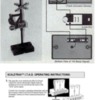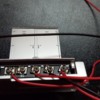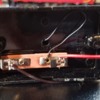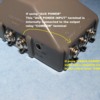I'm having trouble wiring this. I'm using an MTH Scaletrax ITAD to run it. After wiring it (according to the instructions) I get a short when powering it up. Any ideas?
Replies sorted oldest to newest
I'd first confirm the ITAD and Banjo work by themselves (not connected). By powering just the ITAD you should be able to hear its internal relay click-on when triggered and then click-off after whatever delay you set. By directly powering just the banjo, it should just start operating wagging/flashing.
stan2004 posted:I'd first confirm the ITAD and Banjo work by themselves (not connected). By powering just the ITAD you should be able to hear its internal relay click-on when triggered and then click-off after whatever delay you set. By directly powering just the banjo, it should just start operating wagging/flashing.
Banjo signal works. The ITAD clicks but when wired, no short but signal doesn't trigger when beam is broken. I think the ITAD could be broken.
Heres the Inside of the unit.
Attachments
Trainlover9943 posted:Heres the Inside of the unit.


Hi Matt: Well done..............
Gary
trainroomgary posted:Trainlover9943 posted:Heres the Inside of the unit.
Hi Matt: Well done..............
Gary
Thanks.
Trainlover9943 posted:stan2004 posted:I'd first confirm the ITAD and Banjo work by themselves (not connected). By powering just the ITAD you should be able to hear its internal relay click-on when triggered and then click-off after whatever delay you set. By directly powering just the banjo, it should just start operating wagging/flashing.
Banjo signal works. The ITAD clicks but when wired, no short but signal doesn't trigger when beam is broken. I think the ITAD could be broken.
If the ITAD relay "clicks" on then off in response to waving your hand (or whatever) in front of the sensor window, I'd say there's a 99% chance that the ITAD is working. The MTH instructions for your two devices are somewhat vague in how to hook them together.
Are the 5 screw terminals on the ITAD labeled? How exactly is your Banjo hooked to the ITAD?
Attachments
Yes the screws are labeled. Heres how its wired. ITAD: Aux inputs going to hot and common. Common terminal going to hot power. Normally open going to banjo signal (terminal with wire) Common on banjo is going to common power.
Attachments
I've been patiently waiting for someone to post photos of the guts of the MTH Scaletrax ITAD!
Since you have the ITAD open, look carefully at the wiring on the 5 inside terminals of the screw-strip. I believe you will find that the "COM" terminal is internally connected to one of the AUX power terminals. I say this because that's how the MTH Realtrax ITAD is wired:
If this is the case with the Scaletrax ITAD:
- disconnect the red wire with hot power that is now connected to ITAD "COM" screw terminal
- disconnect the Banjo black wire from common power; instead, run this black wire to the ITAD "COM" screw terminal
In other words, the 2 Banjo wires directly connect to just the ITAD. Red to "NO", Black to "COM".
Attachments
stan2004 posted:I've been patiently waiting for someone to post photos of the guts of the MTH Scaletrax ITAD!
Since you have the ITAD open, look carefully at the wiring on the 5 inside terminals of the screw-strip. I believe you will find that the "COM" terminal is internally connected to one of the AUX power terminals. I say this because that's how the MTH Realtrax ITAD is wired:
If this is the case with the Scaletrax ITAD:
- disconnect the red wire with hot power that is now connected to ITAD "COM" screw terminal
- disconnect the Banjo black wire from common power; instead, run this black wire to the ITAD "COM" screw terminal
In other words, the 2 Banjo wires directly connect to the ITAD. Red to "NO", Black to "COM".
Thanks. I'll check it out and give that a try.
Whatever the outcome, if you have the time I'd appreciate if you could post a few more photos of the guts of the ITAD such as the internal screw-strip wiring I mentioned earlier. Questions like yours about how to wire the ITAD to a "fill-in-the-blank" accessory come up regularly because the manufacturer instructions are non-existent or vague.
I've taken it upon myself to study the guts of these widgets so I can give informed answers. OGR members have even sent me their broken ITADs so I could do a teardown! For example here's the teardown on the MTH Realtrax ITAD with lots of photos which is the basis for my suggestion as to your Banjo wiring problem.
stan2004 posted:Whatever the outcome, if you have the time I'd appreciate if you could post a few more photos of the guts of the ITAD such as the internal screw-strip wiring I mentioned earlier. Questions like yours about how to wire the ITAD to a "fill-in-the-blank" accessory come up regularly because the manufacturer instructions are non-existent or vague.
I've taken it upon myself to study the guts of these widgets so I can give informed answers. OGR members have even sent me their broken ITADs so I could do a teardown! For example here's the teardown on the MTH Realtrax ITAD with lots of photos which is the basis for my suggestion as to your Banjo wiring problem.
I'll try my best to do that for you.
Well it works kinda...
Attachments
The ITAD shoots an IR beam toward the track and looks for a reflection from a passing train. As it turns out, ambient room-lighting or sunlight from a window can masquerade as a reflection and falsely trigger the ITAD. I'd darken the room to see if it still triggers when you tilt it up as you do in the video.
Additionally, the ITAD should have a "Range" screwdriver adjustment. which sets the amount of reflected light that triggers the ITAD. If you confirm you do have an ambient light issue, we can go from there.
stan2004 posted:The ITAD shoots an IR beam toward the track and looks for a reflection from a passing train. As it turns out, ambient room-lighting or sunlight from a window can masquerade as a reflection and falsely trigger the ITAD. I'd darken the room to see if it still triggers when you tilt it up as you do in the video.
Additionally, the ITAD should have a "Range" screwdriver adjustment. which sets the amount of reflected light that triggers the ITAD. If you confirm you do have an ambient light issue, we can go from there.
With the room lights off it works.
Attachments
stan2004 posted:The ITAD shoots an IR beam toward the track and looks for a reflection from a passing train. As it turns out, ambient room-lighting or sunlight from a window can masquerade as a reflection and falsely trigger the ITAD. I'd darken the room to see if it still triggers when you tilt it up as you do in the video.
Additionally, the ITAD should have a "Range" screwdriver adjustment. which sets the amount of reflected light that triggers the ITAD. If you confirm you do have an ambient light issue, we can go from there.
With the room lights off it works.
The "Range" adjustment sets the amount of reflected IR light needed to trigger the ITAD. Kind of backwards thinking but increasing the range (i.e., distance to a passing train..or to your waving hand on the test-bench) reduces the amount of required light. So. If ambient light is falsely triggering the ITAD, decrease the "Range" so that more reflected light is required to trigger. Experimentation required.
Position the ITAD away from ambient light sources (lamps, ceiling lights, windows) though obviously not practical for most layouts. Some guys have success adding what amounts to a "window awning" over the ITAD's sensor window. This can be as simply as a folded piece of dark paper. The idea is to give the ITAD what amounts to tunnel-vision looking only straight out to the track rather than any extraneous overhead lighting. From your earlier photo, the ITAD sends out an IR beam thru the clear TX component and receives/detects the reflected beam via the dark RX component.
There are other manufacturers of infrared occupancy detectors that are more tolerant of ambient light. The general method is to pulse the IR beam at some frequency and then look for only that pulsed IR reflection. This rejects (ignores) any steady IR energy such as would be coming from a lamp or ceiling light. The Lionel 153IR is one example.
For what it's worth, the most common advice for your situation would be to use the insulated outer rail method as has been used for occupancy detection since day one of 3-rail O gauge.
















